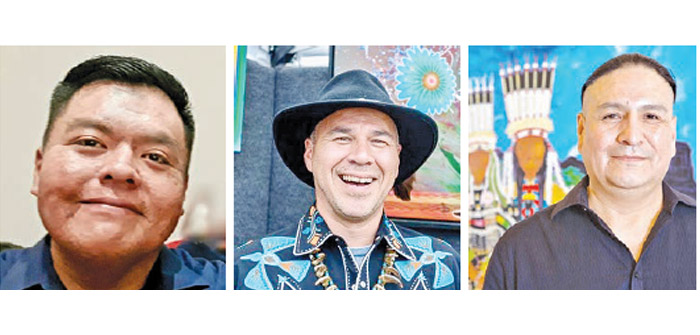(L-R) Jason Parrish, Navajo; Roger Perkins, Mohawk and Terrance Guardipee, Blackfeet
The two dimensional works of artists Terrance Guardipee, Blackfeet, Jason Parrish, Navajo, and Roger Perkins Mohawk, span our concepts of what traditional and contemporary Native American art looks like. Their works can also begin the challenging dilemma of articulating why a work should be considered with either of these two authoritative terms.
Typically, ‘traditional’ is thought of as works based upon time-honored, older perspectives along with current works that respect the heritage and legacy that guided earlier artists. In that case, Jason’s and many of Terrance’s works must be seen as traditional.
Jason paints in the Santa Fe School tradition that began in the 1930’s, a movement strongly influenced by the Ledger Art that preceded it. Ledger art, before that, came directly from the buffalo hide paintings.
A certain ‘less is more’ conceptual approach may describe Jason’s desert scenes of the Diné in elegant poses or in motion on horseback. Jason’s recent second showing at the juried International Watercolor Exhibition, held in the Grand Palais on the Champs Elysees of Paris, demonstrates growing international recognition for his works.
Terrance works in the Ledger Art genre, which uses pages from ledger books of the late 1800’s. When the buffalo were killed off and the people were sent onto reservations — or, for many of the warriors, into prisons — officials began giving the former painting-upon-buffalo-hide artists used ledger pages as material for them to continue their pictorial recordings of history.
Terrance not only paints upon antique ledger pages, he was the artist most instrumental in reviving this narrative art form in the 1990’s. His works can be found in numerous museums throughout the United States, including the Smithsonian.
‘Contemporary’ is thought of as works that allow an artist to explore new possibilities, to offer what might be, thus possibly adding to a culture. In that case, Roger and many of Terrance’s works must be regarded as contemporary.
Roger’s favored medium is Pop Art. His pieces make bold statements about the Native American world. In one work, the iconic black and white photo of Sitting Bull looking straight at you with pride, defiance, and a withering gaze has the great chief’s head encircled by a pink halo. Roger also depicts him wearing dark sunglasses, perhaps disallowing a direct look into the eyes of the warrior — holy man — chieftain.
Roger gives the following reason for working in the pop art style, “For years, we’ve had these iconic monochrome photos staring out at us, reminding us of what we were and won’t ever be again. That can get depressing. We have a now! We have a future! It needs to be colorful, energetic, humorous, and positive. That’s what I’m showing in my works.”
Terrance gathers antique paper items — a ledger page, bank note, map, a photo — to create collages of past times. This ephemera provides a complex backdrop to the powerful Blackfeet imagery that he then draws upon it. Additionally, his vibrant acrylic paintings push into modernist styles, ranging from Fauvism to Expressionism to Pop Art.
This methodology of looking at artwork — traditional or contemporary — comes about because of a sequence we intuitively undertake without realizing it. It goes — first identify, then analyze. That’s followed by define, characterize, and classify. We know this as ‘organization.’ When considering similar things over a long period of time, we further organize into periods or eras. However, it’s a slippery slope.
Blue jeans illustrate this point. We have it in our minds that they came into fashion among the youth of the 1950’s and were somewhat rebellious and most definitely a contemporary fashion. Now, those very same jeans are traditional, unless they’re stylishly distressed, ultra skinny, or have a frayed capri design. Then, they’re contemporary.
Denim fabric has actually been around for centuries, originating in India as dungaree cloth, something favored by 16th Century Portuguese sailors. This material made its way back to Europe, was reimagined in Southern France as denim, and eventually branded by Levi Strauss in the 1870’s. What’s been going on all this time is—cloth materials have been evolving in the hands of humankind.
When we plunk down our considerations at a particular moment in time, like the 1950’s, we give it a label, rebellious fad, or nowadays, classic look. We’re quite good at pigeonholing. Whether it’s with clothing, Native American or European artwork, we do it.
These very topics — traditional and contemporary; stasis, transition, evolution — will be discussed Saturday afternoon in a panel/ open forum conversation. Please join these artists for insightful considerations about Native American art — then, now and tomorrow.
The artists will be having their show in Sisters June 21-23.
Friday: Artist Reception from 4-7pm with non-alcoholic refreshments/ finger food.
Saturday: Artists available 11am-5pm, with the panel discussion beginning at 1:30pm.
Sunday: Artists available 11am until mid-afternoon.
All events will take place at Raven Makes Gallery, 182 E Hood Ave.

